Analys
Det dramatiska året då två karteller bröt samman – Årskrönika 2014

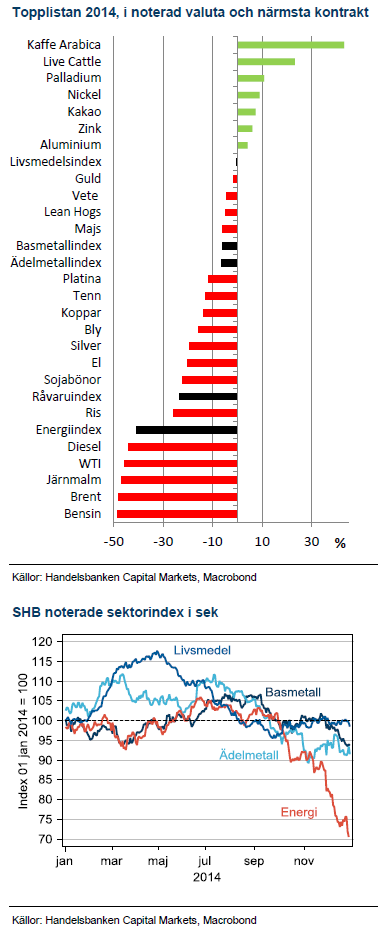 Efterfrågan är inte problemet
Efterfrågan är inte problemet
Råvaror har nu avslutat det tredje året i rad som sämsta tillgångsklass och det är många som pekar ut svag global BNP som drivkraften. Visserligen är Kinas inbromsning och framförallt gir till mindre råvarukonsumerade tillväxt ett av skälen men USA:s ekonomi har slagit alla förväntningar och avslutar året med starkaste tillväxten sedan 2003. Istället kan de flesta stora prisrörelserna tillskrivas utbudssidan av prisekvationen i råvarumarknaden.
Olja och järnmalm halverades
Två av råvaruindustrins starkaste producentkarteller bröt samman under 2014. Mest omskrivet var det faktum att oljekartellen OPEC abdikerade från sin roll som prisgarant. Konsekvensen av detta var att Brentolja föll 48 % och blev årets förlorare, tätt följd av järnmalm som också nära halverades under året som gick. De fyra största järnmalmsbolagen släppte till slut alla hämningar och investerade i ny gruvproduktion som kommer ge ett långvarigt överskott för att hindra nya marginalproducenter från att anträda marknaden. Ett sista bevis på att supercykeln är över och att producenternas grepp om marknaden lättar är att priserna på de flesta råvaror har återvänt ner till produktionskostnaden.
Breda nedgångar och tunt i toppen
För andra året i rad slutade samtliga fyra råvarusektorer; livsmedel, energi, basmetaller och ädelmetaller på minus. En förstärkning av USD mot SEK med 17,4% hjälpte de SEKnoterade indexen men räckte inte till för positiv avkastning. Råvaror som slutade året på plus var det ont om men tre av sex basmetaller slutade upp med nickel som vinnare i sektorn. Även här är det utbudsdramatik som ligger bakom prisrörelsen när Indonesien införde exportförbud för bland annat nickelmalm, vilket minskade världens utbud med 20%. Marknaden har betat av lager och står nu inför nickelbrist under 2015. Årets vinnare var, precis som vanligt, en väderdrabbad jordbruksråvara; kaffe från torkans Brasilien.
Geopolitisk risk blev makrotemat
Rysslands stora betydelse för råvarumarknanden kom i ljuset när Ryssland annekterade Krim under första halvåret. Priserna på olja steg i takt med rädlsan för att Väst skulle bemöta aktionen med exportsanktioner. Så blev inte fallet och riskpremien pös ut. Vetepriset steg också kraftig under mars efter oro för att Ukrainas produktion skulle bli lidande. Ebolautbrottet fick sin återspegling i råvarumarknaden i form av stigande pris på kakao som till 60% produceras i Västra Afrika.
Producentvalutor i skottgluggen
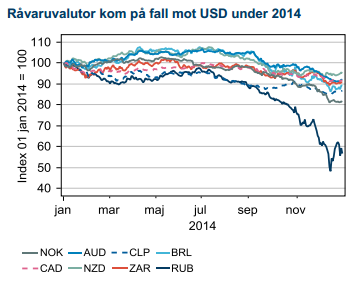 Med fallande råvarupriser och stark USD har råvaruvalutor kommit på fall. Norska kronan var den svagaste av alla industrinationer med ett fall på 19% mot USD. Fallet accelererade i december när Norges bank sänkte räntan och varnade för spridningseffekter till övriga ekonomin efter oljeprisfallet. Norges krona är dock i gott sällkap; Kanada dollar och Australien dollar föll båda med 9% medan Nya Zeelands valuta som mer beror på jordbruksråvaror än olja föll med 6%. Bland utvecklingsekonomierna föll Rysslands rubel 41% efter att passerat en lägsta notering någonsin mot USD i mitten av december. Chiles peso föll med kopparpriset, både koppar och peson gick ner 14% under året. Brasiliens stora råvaruekonomi fick ett tufft år med en halvering av olja och järnmalm och real slutade 11% ner. Sydafrikas rand föll 9% när både platina och guld slutade på minus.
Med fallande råvarupriser och stark USD har råvaruvalutor kommit på fall. Norska kronan var den svagaste av alla industrinationer med ett fall på 19% mot USD. Fallet accelererade i december när Norges bank sänkte räntan och varnade för spridningseffekter till övriga ekonomin efter oljeprisfallet. Norges krona är dock i gott sällkap; Kanada dollar och Australien dollar föll båda med 9% medan Nya Zeelands valuta som mer beror på jordbruksråvaror än olja föll med 6%. Bland utvecklingsekonomierna föll Rysslands rubel 41% efter att passerat en lägsta notering någonsin mot USD i mitten av december. Chiles peso föll med kopparpriset, både koppar och peson gick ner 14% under året. Brasiliens stora råvaruekonomi fick ett tufft år med en halvering av olja och järnmalm och real slutade 11% ner. Sydafrikas rand föll 9% när både platina och guld slutade på minus.
De svaga råvaruvalutorna kommer att få stor betydelse för råvarupriserna under 2015. De flesta producenter har lejonparten av sina produktionskostnader i lokal valuta samtidigt som de säljer råvarorna i USD. De stora valutarörelserna under 2014 sänker därför produktionskostnaden.
Olja tog alla rubriker
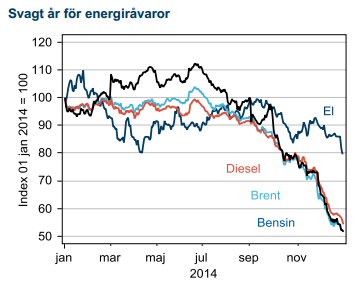 Sällan har ett OPEC-möte varit så emotsett som det andra för 2014 som gick av stapeln den 27:e november. Opec lyckades sänka den redan svaga oljemarknaden ytterligare och både Brent och WTI föll 20 % under de efterföljande två veckorna. OPEC:s beslut att inte sänka produktionen blev slutet på fyra år av höga och stabila priser. När OPEC, åtminstone temporärt abdikerat, sätter marknaden priset. För en marknad i tillfälligt överskott blir priset lågt. Olja är en kapitalintensiv, cyklisk industri och tillfälliga perioder av låga priser utan incitament till nya investeringar skapar förutsättningar för nästa prisuppgång. Denna cykel är dock annorlunda då USA:s skifferoljeproducenter har anträtt marknaden. Under 2015 ska deras flexibla produktionsapparat testas i en lågprismiljö för första gången. Utkomsten avgör nya jämviktspriset som marknaden i dag prisar omkring 78 USD/fat – lägre än vad som prisades under finanskrisen i december 2008
Sällan har ett OPEC-möte varit så emotsett som det andra för 2014 som gick av stapeln den 27:e november. Opec lyckades sänka den redan svaga oljemarknaden ytterligare och både Brent och WTI föll 20 % under de efterföljande två veckorna. OPEC:s beslut att inte sänka produktionen blev slutet på fyra år av höga och stabila priser. När OPEC, åtminstone temporärt abdikerat, sätter marknaden priset. För en marknad i tillfälligt överskott blir priset lågt. Olja är en kapitalintensiv, cyklisk industri och tillfälliga perioder av låga priser utan incitament till nya investeringar skapar förutsättningar för nästa prisuppgång. Denna cykel är dock annorlunda då USA:s skifferoljeproducenter har anträtt marknaden. Under 2015 ska deras flexibla produktionsapparat testas i en lågprismiljö för första gången. Utkomsten avgör nya jämviktspriset som marknaden i dag prisar omkring 78 USD/fat – lägre än vad som prisades under finanskrisen i december 2008
Lägsta elkonsumtionen sedan 1986
El slutade för andra året i rad på minus 20 %. Efterfrågan i Sverige var den lägsta på 30 år. Tung industri fortsätter minska sin konsumtion samtidigt som det varma vädret och ett kolpris som föll med 12 % agerade sänke. Åren med höga elpriser är nu ett minne blott och priset är nere på 2007 års nivåer
Järnmalm nära en halvering
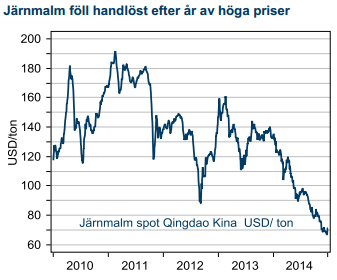 Kinas extrema hunger på stål kom till ett abrupt slut under 2014. Året började med en inhemsk tillväxttakt i stålkonsumtion på 7% och slutade på -3%. Samtidigt kom resultatet från år av investeringar i ny gruvproduktion. Produktionen av järnmalm för exportmarknaden växte med 12% när Rio Tinto, BHP Billiton, Vale och Fortescue ökade kapaciteten. Efterfrågan ökade samtidigt blott med 9% när inhemska kinesiska järnmalmsgruvor inte stängde ner sin olönsamma högkostnadsproduktion i den utsträckning marknaden förväntat sig. Överskottet pressade priset och de stora bolagen som en gång formade ett oligopol blev anklagade för att förstöra marknaden. De försvarade sig med att strategin var att hindra marginalproducenter före de anträder marknaden. Året såg också flera konkurser bland nyetablerade marginalproducenter, inte minst i Sverige.
Kinas extrema hunger på stål kom till ett abrupt slut under 2014. Året började med en inhemsk tillväxttakt i stålkonsumtion på 7% och slutade på -3%. Samtidigt kom resultatet från år av investeringar i ny gruvproduktion. Produktionen av järnmalm för exportmarknaden växte med 12% när Rio Tinto, BHP Billiton, Vale och Fortescue ökade kapaciteten. Efterfrågan ökade samtidigt blott med 9% när inhemska kinesiska järnmalmsgruvor inte stängde ner sin olönsamma högkostnadsproduktion i den utsträckning marknaden förväntat sig. Överskottet pressade priset och de stora bolagen som en gång formade ett oligopol blev anklagade för att förstöra marknaden. De försvarade sig med att strategin var att hindra marginalproducenter före de anträder marknaden. Året såg också flera konkurser bland nyetablerade marginalproducenter, inte minst i Sverige.
Blandad utveckling för basmetaller
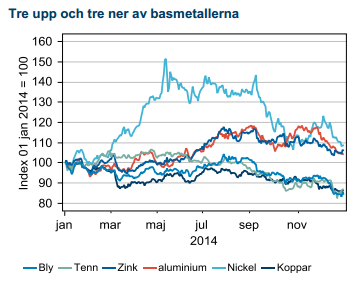 Dramatiken började i mars då Kinas makrodata oväntat föll handlöst. Främst industriproduktionen var svag och fick koppar att komma under press. Samtidigt började nickel stiga efter att Indonesien infört exportförbud den 12:e januari. Indonesien står för 20 % av världens produktion. Malmen som produceras där konsumeras främst i Kina och där fanns strategiska lager som gjorde att exportförbudet initialt inte fick stort genomslag. Med rysslandskrisen i mars ändrades tonläget då eventuella sanktioner mot Rysslands oljeexport väntades mötas av exporthinder från Rysslands sida på metaller viktiga för Väst, däribland nickel. Prisuppgången tog fart men dämpades när sanktioner aldrig kom till stånd och Filipinerna överraskande ökade exporten av liknande malm som Indonesien minskat och därmed tillfälligt kompenserade för bortfallet.
Dramatiken började i mars då Kinas makrodata oväntat föll handlöst. Främst industriproduktionen var svag och fick koppar att komma under press. Samtidigt började nickel stiga efter att Indonesien infört exportförbud den 12:e januari. Indonesien står för 20 % av världens produktion. Malmen som produceras där konsumeras främst i Kina och där fanns strategiska lager som gjorde att exportförbudet initialt inte fick stort genomslag. Med rysslandskrisen i mars ändrades tonläget då eventuella sanktioner mot Rysslands oljeexport väntades mötas av exporthinder från Rysslands sida på metaller viktiga för Väst, däribland nickel. Prisuppgången tog fart men dämpades när sanktioner aldrig kom till stånd och Filipinerna överraskande ökade exporten av liknande malm som Indonesien minskat och därmed tillfälligt kompenserade för bortfallet.
Aluminium inledde året på pressade nivåer då flera stora producenter stängde ner olönsam produktion. Metallen fick ett välbehövligt lyft när Amerikansk makrodata simultant överraskade positivt och bilindustrin Väster om Atlanten gick som tåget och planerade substituera in mer aluminium för att reducera vikten i fordonen. Överkapaciteten i världen för att producera aluminium är dock stor och årets två prisrallyn fick båda abrupta slut omkring 2100 USD/ton och året slutade i den gamla välkända gråzonen kring 1800 USD.
Zink steg under året, delvis av samma skäl som aluminium –båda har stor exponering mot USA och bilindustrin. Zink steg också när det länge välkända scenariot då några stora, utbrutna zinkgruvor ska stänga närmar sig. 2015 blir året då det ska visa sig om många små gruvor kommer expandera och kompensera bortfallet.
Ädelmetaller
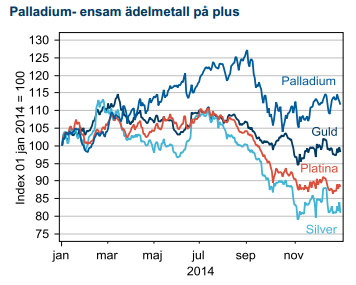 Palladium var ytterligare en av de råvaror som handlades upp på risken att Ryssland skulle minska tillgången till Väst som motdrag till eventuella exportsanktioner på olja. Palladiumexport har litet värde för Ryssland men metallen är viktigt för västerländsk bilindustri. Produktionen domineras av ett fåtal länder och prisuppgången eskalerade då Sydafrika är ett av dem och landet har haft sin beskärda del av motgångar under fjolåret. Våldsamma strejker har avlöst varandra men upplösningen fick priset på både palladium och platina på fall.
Palladium var ytterligare en av de råvaror som handlades upp på risken att Ryssland skulle minska tillgången till Väst som motdrag till eventuella exportsanktioner på olja. Palladiumexport har litet värde för Ryssland men metallen är viktigt för västerländsk bilindustri. Produktionen domineras av ett fåtal länder och prisuppgången eskalerade då Sydafrika är ett av dem och landet har haft sin beskärda del av motgångar under fjolåret. Våldsamma strejker har avlöst varandra men upplösningen fick priset på både palladium och platina på fall.
Guld och silver har åter varit föremål för Feds ordlek kring när den kommande räntehöjningen skall äga rum. De båda ädla värdebevararna steg kraftigt på Feds expansiva politik och befinner sig nu i en korrigering parallellt med att räntepolitiken åter går mot normalisering.
Jordbuk handlades inte endast på väder
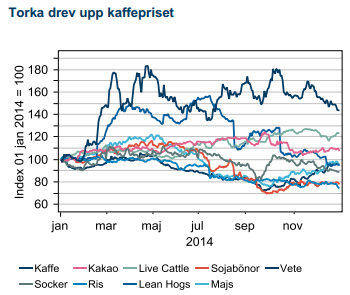 Jordbruksråvarornas största prisrörelser brukar vara väderberoende då tillväxten i konsumtionen är relativt konstant. Fjolåret var inget undantag då året inleddes med ett rally i kaffe. Från slutet av januari till början av mars steg kaffepriset med 80% när största producenten Brasilien drabbats av den värsta torkan på decennier, vilket förde priset på kaffebönorna till det högsta på två år.
Jordbruksråvarornas största prisrörelser brukar vara väderberoende då tillväxten i konsumtionen är relativt konstant. Fjolåret var inget undantag då året inleddes med ett rally i kaffe. Från slutet av januari till början av mars steg kaffepriset med 80% när största producenten Brasilien drabbats av den värsta torkan på decennier, vilket förde priset på kaffebönorna till det högsta på två år.
Därefter var det dock geopolitisk risk som drev upp priset på jordbruksråvaror. Vetepriset steg med 25% från mars till maj när Rysslands aggressioner antogs påverka Ukrainas veteproduktion via brist på krediter, diesel, gödning och utsäde. Farhågorna var dock felaktiga och de producenter som sålde skörden 2014 i maj när riskpremien var som störst kunde tjäna 34% på hedgen fram till september då priset bottnade. Därefter startade en ny prisuppgång på 38% fram till december, åter beroende på Ryssland. Denna gång spekulerades det i risk för exportrestriktioner från Rysslands sida efter att rubelfallet ökat incitamenten för inhemska spannmålshandlare att exportera vete. Ryska politiker vill undvika matinflation och sade sig överväga alla medel utom regelrätt exportförbud för att hindra vetet att lämna landet. Globala säkerhetslager är dock betryggande och priset slutade året i ny utförslöpa och den andra riskpremien är kanske chansen att sälja skörden för 2015?
[box]Krönikan är producerat av Handelsbanken och publiceras i samarbete och med tillstånd på Råvarumarknaden.se[/box]
Ansvarsbegränsning
Detta material är producerat av Svenska Handelsbanken AB (publ) i fortsättningen kallad Handelsbanken. De som arbetar med innehållet är inte analytiker och materialet är inte oberoende investeringsanalys. Innehållet är uteslutande avsett för kunder i Sverige. Syftet är att ge en allmän information till Handelsbankens kunder och utgör inte ett personligt investeringsråd eller en personlig rekommendation. Informationen ska inte ensamt utgöra underlag för investeringsbeslut. Kunder bör inhämta råd från sina rådgivare och basera sina investeringsbeslut utifrån egen erfarenhet.
Informationen i materialet kan ändras och också avvika från de åsikter som uttrycks i oberoende investeringsanalyser från Handelsbanken. Informationen grundar sig på allmänt tillgänglig information och är hämtad från källor som bedöms som tillförlitliga, men riktigheten kan inte garanteras och informationen kan vara ofullständig eller nedkortad. Ingen del av förslaget får reproduceras eller distribueras till någon annan person utan att Handelsbanken dessförinnan lämnat sitt skriftliga medgivande. Handelsbanken ansvarar inte för att materialet används på ett sätt som strider mot förbudet mot vidarebefordran eller offentliggörs i strid med bankens regler.
Analys
Brent crude set to dip its feet into the high $50ies/b this week

Parts of the Brent crude curve dipping into the high $50ies/b. Brent crude fell 2.3% over the week to Friday. It closed the week at $61.29/b, a slight gain on the day, but also traded to a low of $60.14/b that same day and just barely avoided trading into the $50ies/b. This morning it is risk-on in equities which seems to help industrial metals a little higher. But no such luck for oil. It is down 0.8% at $60.8/b. This week looks set for Brent crude to dip its feet in the $50ies/b. The Brent 3mth contract actually traded into the high $50ies/b on Friday.

The front-end backwardation has been on a weakening foot and is now about to fully disappear. The lowest point of the crude oil curve has also moved steadily lower and lower and its discount to the 5yr contract is now $6.8/b. A solid contango. The Brent 3mth contract did actually dip into the $50ies/b intraday on Friday when it traded to a low point of $59.93/b.
More weakness to come as lots of oil at sea comes to ports. Mid-East OPEC countries have boosted exports along with lower post summer consumption and higher production. The result is highly visibly in oil at sea which increased by 17 mb to 1,311 mb over the week to Sunday. Up 185 mb since mid-August. On its way to discharge at a port somewhere over the coming month or two.
Don’t forget that the oil market path ahead is all down to OPEC+. Remember that what is playing out in the oil market now is all by design by OPEC+. The group has decided that the unwind of the voluntary cuts is what it wants to do. In a combination of meeting demand from consumers as well as taking back market share. But we need to remember that how this plays out going forward is all at the mercy of what OPEC+ decides to do. It will halt the unwinding at some point. It will revert to cuts instead of unwind at some point.
A few months with Brent at $55/b and 40-50 US shale oil rigs kicked out may be what is needed. We think OPEC+ needs to see the exit of another 40-50 drilling rigs in the US shale oil patches to set US shale oil production on a path to of a 1 mb/d year on year decline Dec-25 to Dec-26. We are not there yet. But a 2-3 months period with Brent crude averaging $55/b would probably do it.
Oil on water increased 17 mb over the week to Sunday while oil in transit increased by 23 mb. So less oil was standing still. More was moving.

Crude oil floating storage (stationary more than 7 days). Down 11 mb over week to Sunday

The lowest point of the Brent crude oil curve versus the 5yr contract. Weakest so far this year.

Crude oil 1mth to 3mth time-spreads. Dubai held out strongly through summer, but then that center of strength fell apart in late September and has been leading weakness in crude curves lower since then.

Analys
Crude oil soon coming to a port near you

Rebounding along with most markets. But concerns over solidity of Gaza peace may also contribute. Brent crude fell 0.8% yesterday to $61.91/b and its lowest close since May this year. This morning it is bouncing up 0.9% to $62.5/b along with a softer USD amid positive sentiment with both equities and industrial metals moving higher. Concerns that the peace in Gaza may be less solid than what one might hope for also yields some support to Brent. Bets on tech stocks are rebounding, defying fears of trade war. Money moving back into markets. Gold continues upwards its strong trend and a softer dollar helps it higher today as well.

US crude & products probably rose 5.6 mb last week (API) versus a normal seasonal decline of 2.4 mb. The US API last night partial and thus indicative data for US oil inventories. Their data indicates that US crude stocks rose 7.4 mb last week, gasoline stocks rose 3.0 mb while Distillate stocks fell 4.8 mb. Altogether an increase in commercial crude and product stocks of 5.6 mb. Commercial US crude and product stocks normally decline by 2.4 mb this time of year. So seasonally adjusted the US inventories rose 8 mb last week according to the indicative numbers by the API. That is a lot. Also, the counter seasonal trend of rising stocks versus normally declining stocks this time of year looks on a solid pace of continuation. If the API is correct then total US crude and product stocks would stand 41 mb higher than one year ago and 6 mb higher than the 2015-19 average. And if we combine this with our knowledge of a sharp increase in production and exports by OPEC(+) and a large increase in oil at sea, then the current trend in US oil inventories looks set to continue. So higher stocks and lower crude oil prices until OPEC(+) switch to cuts. Actual US oil inventory data today at 18:00 CET.
US commercial crude and product stocks rising to 1293 mb in week 41 if last nights indicative numbers from API are correct.

Crude oil soon coming to a port near you. OPEC has lifted production sharply higher this autumn. At the same time demand for oil in the Middle-East has fallen as we have moved out of summer heat and crude oil burn for power for air-conditioning. The Middle-East oil producers have thus been able to lift exports higher on both accounts. Crude oil and condensates on water has shot up by 177 mb since mid-August. This oil is now on its way to ports around the world. And when they arrive, it will likely help to lift stocks onshore higher. That is probably when we will lose the last bit of front-end backwardation the the crude oil curves. That will help to drive the front-month Brent crude oil price down to the $60/b line and revisit the high $50ies/b. Then the eyes will be all back on OPEC+ when they meet in early November and then again in early December.
Crude oil and condensates at sea have moved straight up by 177 mb since mid-August as OPEC(+) has produced more, consumed less and exported more.

Analys
The Mid-East anchor dragging crude oil lower

When it starts to move lower it moves rather quickly. Gaza, China, IEA. Brent crude is down 2.1% today to $62/b after having traded as high as $66.58/b last Thursday and above $70/b in late September. The sell-off follows the truce/peace in Gaze, a flareup in US-China trade and yet another bearish oil outlook from the IEA.

A lasting peace in Gaze could drive crude oil at sea to onshore stocks. A lasting peace in Gaza would probably calm down the Houthis and thus allow more normal shipments of crude oil to sail through the Suez Canal, the Red Sea and out through the Bab-el-Mandeb Strait. Crude oil at sea has risen from 48 mb in April to now 91 mb versus a pre-Covid normal of about 50-60 mb. The rise to 91 mb is probably the result of crude sailing around Africa to be shot to pieces by the Houthis. If sailings were to normalize through the Suez Canal, then it could free up some 40 mb in transit at sea moving onshore into stocks.
The US-China trade conflict is of course bearish for demand if it continues.
Bearish IEA yet again. Getting closer to 2026. Credibility rises. We expect OPEC to cut end of 2025. The bearish monthly report from the IEA is what it is, but the closer we get to 2026, the more likely the IEA is of being ball-park right in its outlook. In its monthly report today the IEA estimates that the need for crude oil from OPEC in 2026 will be 25.4 mb/d versus production by the group in September of 29.1 mb/d. The group thus needs to do some serious cutting at the end of 2025 if it wants to keep the market balanced and avoid inventories from skyrocketing. Given that IEA is correct that is. We do however expect OPEC to implement cuts to avoid a large increase in inventories in Q1-26. The group will probably revert to cuts either at its early December meeting when they discuss production for January or in early January when they discuss production for February. The oil price will likely head yet lower until the group reverts to cuts.
Dubai: The Mid-East anchor dragging crude oil lower. Surplus emerging in Mid-East pricing. Crude oil prices held surprisingly strong all through the summer. A sign and a key source of that strength came from the strength in the front-end backwardation of the Dubai crude oil curve. It held out strong from mid-June and all until late September with an average 1-3mth time-spread premium of $1.8/b from mid-June to end of September. The 1-3mth time-spreads for Brent and WTI however were in steady deterioration from late June while their flat prices probably were held up by the strength coming from the Persian Gulf. Then in late September the strength in the Dubai curve suddenly collapsed. Since the start of October it has been weaker than both the Brent and the WTI curves. The Dubai 1-3mth time-spread now only stands at $0.25/b. The Middle East is now exporting more as it is producing more and also consuming less following elevated summer crude burn for power (Aircon) etc.
The only bear-element missing is a sudden and solid rise in OECD stocks. The only thing that is missing for the bear-case everyone have been waiting for is a solid, visible rise in OECD stocks in general and US oil stocks specifically. So watch out for US API indications tomorrow and official US oil inventories on Thursday.
No sign of any kind of fire-sale of oil from Saudi Arabia yet. To what we can see, Saudi Arabia is not at all struggling to sell its oil. It only lowered its Official Selling Prices (OSPs) to Asia marginally for November. A surplus market + Saudi determination to sell its oil to the market would normally lead to a sharp lowering of Saudi OSPs to Asia. Not yet at least and not for November.
The 5yr contract close to fixed at $68/b. Of importance with respect to how far down oil can/will go. When the oil market moves into a surplus then the spot price starts to trade in a large discount to the 5yr contract. Typically $10-15/b below the 5yr contract on average in bear-years (2009, 2015, 2016, 2020). But the 5yr contract is usually pulled lower as well thus making this approach a moving target. But the 5yr contract price has now been rock solidly been pegged to $68/b since 2022. And in the 2022 bull-year (Brent spot average $99/b), the 5yr contract only went to $72/b on average. If we assume that the same goes for the downside and that 2026 is a bear-year then the 5yr goes to $64/b while the spot is trading at a $10-15/b discount to that. That would imply an average spot price next year of $49-54/b. But that is if OPEC doesn’t revert to cuts and instead keeps production flowing. We think OPEC(+) will trim/cut production as needed into 2026 to prevent a huge build-up in global oil stocks and a crash in prices. But for now we are still heading lower. Into the $50ies/b.
-

 Nyheter3 veckor sedan
Nyheter3 veckor sedanOPEC+ missar produktionsmål, stöder oljepriserna
-

 Nyheter4 veckor sedan
Nyheter4 veckor sedanEtt samtal om guld, olja, fjärrvärme och förnybar energi
-

 Nyheter2 veckor sedan
Nyheter2 veckor sedanGoldman Sachs höjer prognosen för guld, tror priset når 4900 USD
-

 Nyheter3 veckor sedan
Nyheter3 veckor sedanGuld nära 4000 USD och silver 50 USD, därför kan de fortsätta stiga
-

 Nyheter3 veckor sedan
Nyheter3 veckor sedanBlykalla och amerikanska Oklo inleder ett samarbete
-

 Analys4 veckor sedan
Analys4 veckor sedanAre Ukraine’s attacks on Russian energy infrastructure working?
-

 Nyheter4 veckor sedan
Nyheter4 veckor sedanGuldpriset uppe på nya höjder, nu 3750 USD
-

 Nyheter3 veckor sedan
Nyheter3 veckor sedanEtt samtal om guld, olja, koppar och stål








